At this week’s InterGeo Conference, DRONELIFE had the opportunity to meet with Troy Hittle, senseFly‘s General Manager of the US and Canada, and talk about new partnerships, company focus, and what it will take for drones to move mainstream.
senseFly’s fixed wing drone is iconic in the industry. The eBee – and its descendants – were the first of the lightweight, fixed wing, endurance aircraft to make a major impact on the market. While senseFly was founded in 2009 in Switzerland, it’s now a global company with major headquarters in Europe, the U.S., China and New Zealand: and a worldwide impact.
Maintaining that focus hasn’t meant that the product stayed the same. “Over that decade we’ve listened, we figured out what users need, and we’ve evolved,” says Hittle. senseFly now offers a suite of drones and the sensors, software and support that make up a drone solution: and while they started out with a concentration in agriculture – still a major market for the company – they are now taking their core competencies and moving horizontally across industry verticals, providing solutions to a wide variety of industries including solar, construction, environmental monitoring, humanitarian work, surveying and mapping, and mining and aggregates.
Taking Drones Mainstream
While the commercial drone industry is growing, drones aren’t the mainstream, every day tools that they have the potential to be. There are a lot of reasons for that: regulations, ease of use, and enterprise adoption among them. It’s something that Hittle considers carefully. “I’m obsessed with the question about what it takes to go mainstream – and I think that that horizontal movement is key,” says Hittle. “Our core competencies are safety and reliability – so we’re taking enterprise steps while staying light, efficient, and safe. We’re figuring out how to integrate into other workflows.”
In addition to moving their product into new industries, senseFly is working with other industry stakeholders to move drones mainstream through testing and trial that will lead to drone integration. They’re working with the UAS Integration Pilot Program and other programs in the U.S. and internationally to help inform regulation on flight beyond visual line of sight (BVLOS), flight over people, and flight in urban areas. Contributing to those projects, Hittle says, helps develop partnerships in new industries and open up new applications for commercial drones.
Partnerships and Maintaining a Leadership Position
One of the big news senseFly has announced recently is their partnership with Trimble Select for Agriculture. Trimble is a leading name in agriculture, and the partnership means that agronomists will have access to senseFly solutions through the Trimble distributions network.
In addition to adding to senseFly’s distribution network, which Hittle says is an important piece of the company’s success, “Connecting with industry leaders like Trimble opens up different opportunities in the ecosystem,” says Hittle. “senseFly was chosen by Trimble as a partner because of our integration capabilities with MicaSense, the leading agricultural sensor. From the organization standpoint, Trimble is the industry leader in precision agriculture. From the sensor side, MicaSense is the industry leader. And eBee is the platform of choice.”
“eBee is at the center of the ecosystem, but it integrates seamlessly – we focus on the workflows, and close the loop with the user,” he explains. When asked about big goals for next year, Hittle says that senseFly is focused on maintaining their first place position as the global leader in fixed wing UAS, and continuing to be the platform of choice for aggregators.
“The partnerships help us define ourselves as the leader,” says Hittle. “You have to earn that. We want to keep earning it, and continue to accelerate.”
Miriam McNabb is the Editor-in-Chief of DRONELIFE and CEO of JobForDrones, a professional drone services marketplace, and a fascinated observer of the emerging drone industry and the regulatory environment for drones. Miriam has penned over 3,000 articles focused on the commercial drone space and is an international speaker and recognized figure in the industry. Miriam has a degree from the University of Chicago and over 20 years of experience in high tech sales and marketing for new technologies.
For drone industry consulting or writing, Email Miriam.
TWITTER:@spaldingbarker
Subscribe to DroneLife here.
